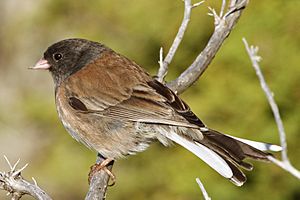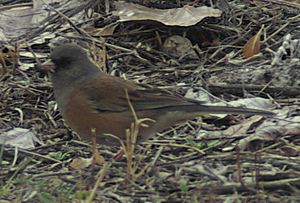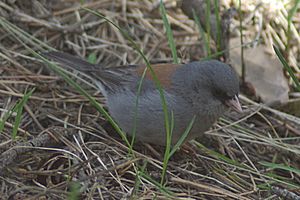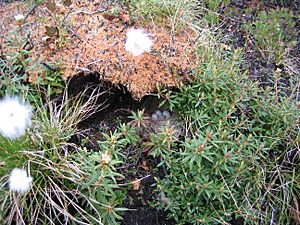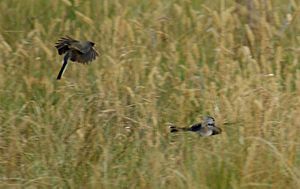Dark-eyed junco facts for kids
Quick facts for kids Dark-eyed junco |
|
|---|---|
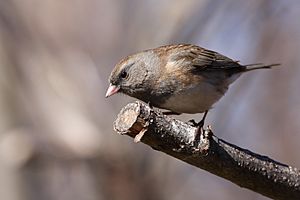 |
|
| Female slate-colored dark-eyed junco (Junco hyemalis hyemalis) | |
| Conservation status | |
| Scientific classification | |
| Genus: |
Junco
|
| Species: |
hyemalis
|
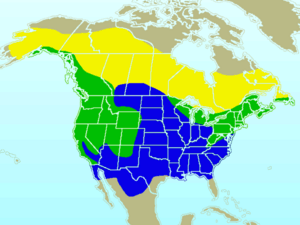 |
|
| Approximate range in North America Breeding range Year-round range Wintering range | |
| Synonyms | |
(but see text) |
|
The dark-eyed junco (Junco hyemalis) is a small, grayish bird. It belongs to a group of birds called New World sparrows. You can find this bird in many parts of North America. In summer, it even flies far north into the Arctic. This bird looks very different depending on where it lives. Scientists are still learning about all its variations.
Contents
What Does the Dark-eyed Junco Look Like?

Adult juncos usually have gray heads, necks, and chests. Their backs and wings can be gray or brown. Their bellies are white. When they fly or hop, you can see their white outer tail feathers flash. Their beaks are usually a pale pink color.
Male juncos often have darker, clearer markings than females. A dark-eyed junco is about 13 to 17.5 centimeters (5 to 7 inches) long. Its wings can spread out 18 to 25 centimeters (7 to 10 inches). These birds usually weigh between 18 and 30 grams (0.6 to 1 ounce).
Young juncos, called juveniles, sometimes have pale streaks. They might look like other sparrows at first. But young juncos usually have heads that are all one color. Their beaks also have yellowish edges when they are very young. These edges help their parents feed them.
Junco Sounds and Calls
The dark-eyed junco's song is a trill, which sounds like a fast, repeated note. It is similar to the song of a chipping sparrow. Some types of juncos have more complex songs. Their calls include quick tick sounds and high-pitched chips. Many bird watchers study juncos to learn about bird communication.
How the Dark-eyed Junco Got Its Name
The dark-eyed junco was first described by a famous scientist named Carl Linnaeus in 1758. He gave it the scientific name Fringilla hyemalis. He simply said it was a "black 'finch' with a white belly" from America.
Linnaeus got his information from another scientist, Mark Catesby. Catesby called this bird the "snow-bird." He noticed that these birds only appeared in Virginia and Carolina during winter. They were most visible when it snowed. He wondered where they went in the summer.
The name Junco comes from a Spanish word for a type of plant called a rush. The scientific name hyemalis means "of the winter" in Latin. So, the bird's modern scientific name means "winter junco."
Different Types of Juncos
There are many different types of dark-eyed juncos. Scientists call these different types "subspecies." These subspecies are grouped into a few main categories. They used to be thought of as separate species. But they often breed with each other where their living areas meet. This means they are all part of the same species.
Slate-colored Juncos
- Slate-colored dark-eyed junco (J. h. hyemalis)
- Carolina dark-eyed junco (J. h. carolinensis)
- Cassiar dark-eyed junco (J. h. cismontanus)
These juncos have dark slate-gray heads, chests, and upper bodies. Female slate-colored juncos are brownish-gray. Sometimes they have reddish-brown sides. They live and have their babies in the northern forests of North America. This includes areas from Alaska to Newfoundland and south to the Appalachian Mountains. In winter, they fly south to most parts of the United States. They are very common birds.
White-winged Juncos
- White-winged dark-eyed junco (J. h. aikeni)
The white-winged dark-eyed junco has a medium-gray head, chest, and upper body. It has white bars on its wings. Females have a brownish color. This type of junco has more white in its tail than other subspecies. It lives and breeds in the Black Hills area of South Dakota and nearby states. In winter, it flies south to northeastern New Mexico.
Oregon or Brown-backed Juncos
- Montana dark-eyed junco (J. h. montanus)
- Oregon dark-eyed junco (J. h. oreganus)
- Point Pinos dark-eyed junco (J. h. pinosus)
- Hanson Laguna dark-eyed junco (J. h. pontilis)
- Shufeldt's dark-eyed junco (J. h. shufeldti)
- Thurber's dark-eyed junco (J. h. thurberi)
- Townsend's dark-eyed junco (J. h. townsendi)
These juncos have a blackish-gray head and chest. Their backs and wings are brown, and their sides are reddish. The colors can be duller and paler in drier areas. This group is the most common type in the western United States. They breed in the mountains along the Pacific Ocean coast. In winter, they fly to the Great Plains and northern Sonora. Some scientists still debate if this large group should be considered its own species.
Pink-sided Juncos
- Pink-sided dark-eyed junco (J. h. mearnsi)
This junco is often grouped with the Oregon juncos. It has a lighter gray head and chest. Its back and wings are brown. It has a rich pinkish-cinnamon color on its sides and chest. This color is stronger than on the Oregon juncos. It breeds in the northern Rocky Mountains and spends winters in central Idaho and nearby areas.
Gray-headed Juncos
- Gray-headed dark-eyed junco (J. h. caniceps)
This junco is mostly light gray on top with a rusty-colored back. It breeds in the southern Rocky Mountains from Colorado to central Arizona and New Mexico. In winter, it flies south into northern Mexico.
Red-backed Juncos
- Red-backed dark-eyed junco (J. h. dorsalis)
This junco is sometimes included with the gray-headed group. It has a silvery beak with a dark upper part and a light lower part. It also has some rust color on its wings and pale underparts. It looks similar to the yellow-eyed junco, but it has dark eyes. It is found in the southern mountains of Arizona and New Mexico.
Guadalupe Juncos
- Guadalupe dark-eyed junco or Guadalupe junco (J. h. insularis or J. insularis)
This type of junco is very rare. Some scientists consider it a separate species, while others see it as a subspecies of the dark-eyed junco. This population has changed faster than the juncos on the mainland. This is because it is a small group living on an island.
Where Do Dark-eyed Juncos Live and What Do They Do?
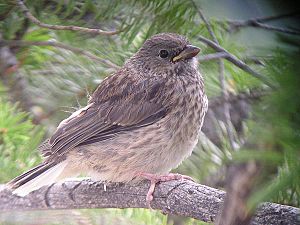
Dark-eyed juncos build their nests in forests with conifer trees or mixed forests across North America. Birds from the northern areas fly south for winter. They arrive in their winter homes between September and November. They leave to breed from March to April. Some juncos stay in the same area all year. Others move to lower elevations in cold years. For example, in the Sierra Nevada mountains, juncos move to lower areas for winter. In winter, juncos are often seen in towns and at bird feeders.
These birds look for food on the ground. In winter, they often feed in groups with different types of juncos. They mostly eat insects and seeds. Sometimes, a large group of juncos is called a "blizzard."
Juncos usually make their nests in a cup-shaped dip on the ground. They hide their nests well with plants or other materials. Sometimes, they build nests in the lower branches of a bush or tree. Their nests are about 10 centimeters (4 inches) wide. They line the nests with fine grasses and hair.
Normally, a female junco lays two sets of four eggs during the breeding season. The eggs are grayish or pale bluish-white. They have many spots of brown, purple, or gray. The spots are usually thicker at the larger end of the egg. The female bird sits on the eggs for 12 to 13 days to keep them warm. The young birds leave the nest when they are 11 to 14 days old.
Images for kids
See also
 In Spanish: Junco pizarroso para niños
In Spanish: Junco pizarroso para niños




